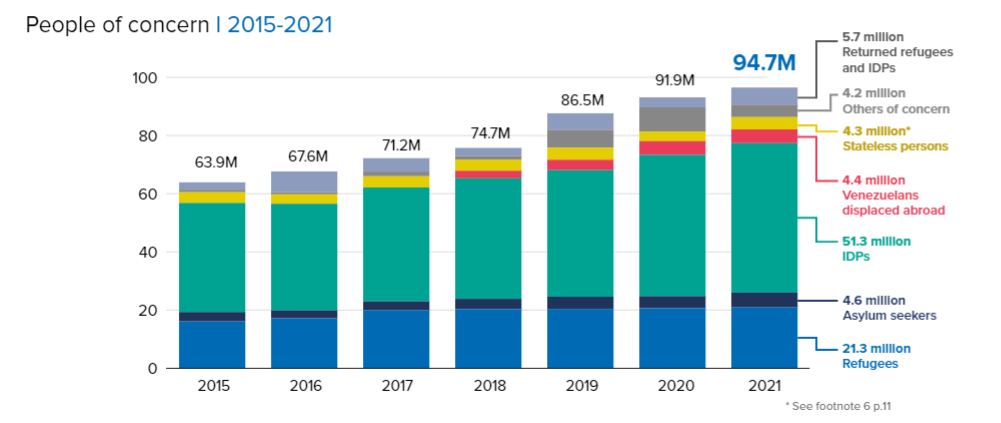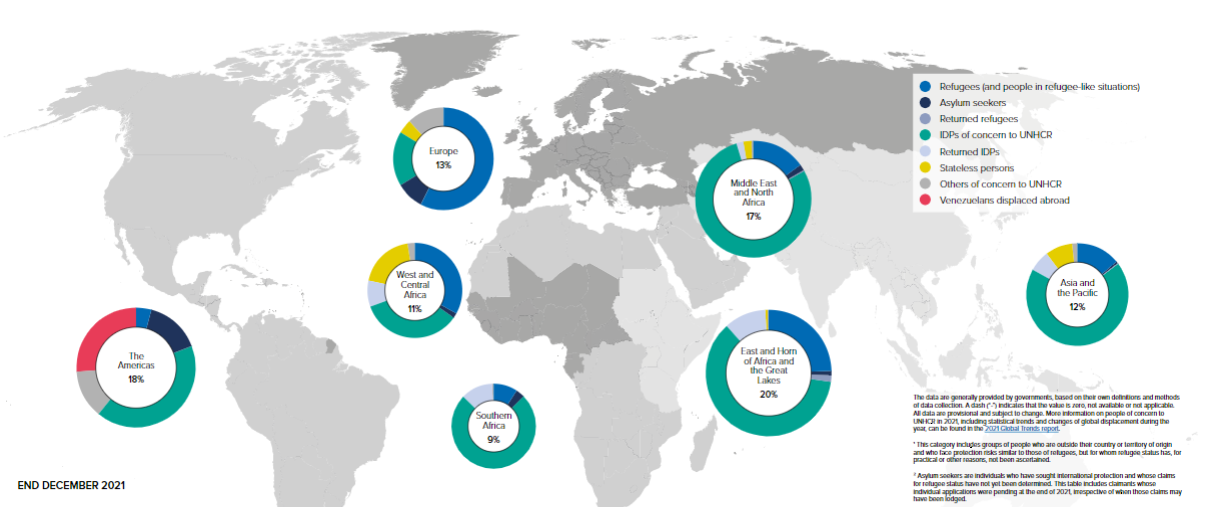The number of those forced to flee their homes has increased every year for the past ten years. In 2021, a new record was reached, reaching the highest level ever.
According to Global Trends, the annual report published on Refugee Day by UNHCR at the end of 2021, there were 89.3 million refugees due to war, violence, persecution and human rights violations, 8% more than the previous year and well over twice as many as 10 years ago. Add to this the refugees caused by the Russian invasion of Ukraine (the fastest and one of the largest forced displacement crises since World War II) and other emergencies from Africa to Afghanistan that brought the total to 100million.
This dossier analyses the UNHCR report and reports on the case of Greece with the dossier produced by Europe Must Act and in collaboration with the Samos Advoacy Collective.
Internally displaced persons and climate change
The number of internally displaced persons (IDPs), mainly due to conflict and violence, is increasing. At the end of 2021, there were 51.3m IDPs, 2.7m more than at the end of 2020. In fact, 2021 saw the 15th consecutive annual increase in the number of people displaced within their countries due to conflict. During the year, UNHCR declared 11 new IDP emergencies in eight countries including Afghanistan, Democratic Republic of Congo, Ethiopia, Mozambique and Myanmar. Insurgencies in the Sahel caused new internal displacements, particularly in Burkina Faso and Chad.
Another distinctive feature of 2021 was the consolidation of the interconnection between climate change, poverty, food insecurity, conflict and displacement. More and more people are seeking safety and security in the face of climate-related threats. Among the many examples from the past year are the floods that have affected South Sudan and the Rohingya refugees, Afghanistan and Somalia that have suffered devastating droughts, and dwindling water resources that have triggered conflict in Cameroon. Ninety per cent of the refugees come from countries on the frontline of the climate emergency. But flight is no guarantee of safety: over 40% of refugees and 70% of IDPs live in countries highly vulnerable to climate change.

The Greek case: the militarised camp of Somos
In addition to the UNHCR report, the report by Europe Must Act and the Samos Advocacy Collective was also published on 20 June. A document recounting the experiences of asylum seekers and refugees living in militarised refugee camps on the Greek island of Samos. In September 2021, European and Greek authorities opened the ‘Closed Controlled Access Centre’ on Samos, the first of five EU-funded closed camps to be built on the Aegean islands. Through a joint project researchers and activists in the field are interviewing residents of the facility to find out what life is really like inside. Following up on the previous report published in December 2021, the text focuses on the testimonies and personal experiences of people who “live like in a prison facility, providing yet more evidence that the EU-funded centre does not uphold the fundamental rights and freedoms of people seeking refuge and that the better living conditions promised by the authorities when the camp opened are just a broken dream”.
To give a few examples: since February 2022, there has been no medical staff in the camp. In May, a technical problem caused a water shortage, leaving camp residents with limited access to water services for 15 consecutive days. The groups also denounce the extreme surveillance of the camp, which is continuously exposed to control by drones, CCTV cameras and a high police presence. But it is not just the case of Samos. On the islands of Leros and Kos, two new Closed Controlled Accesses were recently opened. The activists call it ‘alarming’ that ‘in recent months, other countries and their leaders have shown interest in replicating the new camp on Samos, perceiving it as a ‘best practice model’.
WHO DOES WHAT: Europe Must Act
Europe Must Act is an activist group set up to demand the revision of European migration policy. The group’s main goals are to ‘unite communities across Europe to receive refugees and asylum seekers’, ‘ensure decent reception conditions and alternatives to camps in Greece and along Europe’s external borders’, and ‘ensure a fair and humane European asylum and migration policy’. Europe must Act has created the #CitiesMustAct campaign asking citizens, councils and mayors of European cities to commit to supporting the relocation of asylum seekers and refugees from Europe’s borders to other member states.
FOCUS 1: Who are the 89.3 million displaced people
The 89.3million people on the run consist of: 27.1 million refugees, 21.3 million refugees under UNHCR mandate, 5.8 million Palestinian refugees under UNRWA mandate, 53.2 million IDPs, 4.6 million asylum seekers, 4.4 million Venezuelans displaced abroad. The number of refugees rose in 2021. Many more people were received in Uganda, Chad and Sudan. Once again, most refugees were hosted by neighbouring countries with few resources. The number of asylum seekers reached 4.6 million, an increase of 11%, with 1.4 million new applications. The USA was the world’s largest recipient of new individual applications (188,900), followed by Germany (148,200), Mexico (132,700), Costa Rica (108,500) and France (90,200).
FOCUS 2: Where, and why
In 2021, low- and middle-income countries hosted 83% of the refugees and less developed countries provided asylum to 27% of the total. Seventy-two per cent lived in countries close to their country of origin. Turkey hosted the highest number of refugees with almost 3.8million people. This was followed by Uganda (1.5million), Pakistan (1.5million) and Germany (1.3million). Colombia hosted 1.8million Venezuelans.
In terms of per capita share, Lebanon remains the most welcoming country (1 in 8), followed by Jordan (1 in 14) and Turkey (1 in 23). Compared to their national populations, the island of Aruba hosted the largest number of Venezuelans displaced abroad (1 in 6), followed by the island of Curaçao (1 in 10).
More than two-thirds (69%) of refugees and Venezuelans displaced abroad came from just five countries: Syria (6.8million), Venezuela (4.6million), Afghanistan (2.7million), South Sudan (2.4million) and Myanmar (1.2million).




















